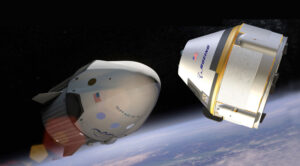Safety panel warns schedule for commercial crew test flights still uncertain

WASHINGTON — As NASA prepares to announce the astronauts who will fly the first commercial crew missions, an independent safety board is cautioning that it is still too soon to sets dates for those flights.
NASA said in a statement last week that it will name the astronauts who will fly the crewed demo flights by Boeing and SpaceX during an event Aug. 3 at the Johnson Space Center. The event will also announce the crews for the first post-certification missions by each company, which will mark the start of routine transportation of astronauts to and from the station by Boeing’s CST-100 Starliner and SpaceX’s Crew Dragon.
The NASA statement did not explicitly state if the agency will also update the schedule for those flights. The latest public schedules, released by NASA early this year, call for uncrewed test flights by both companies in August, followed by crewed test flights by Boeing in November and SpaceX in December. However, delays of at least several months are widely expected for both companies’ test flights.
Members of NASA’s Aerospace Safety Advisory Panel (ASAP) appeared to caution against flying at least the crewed demonstration flights in the near future. “We see both continued progress and a large volume of work ahead” for the commercial crew program, said Patricia Sanders, chair of ASAP, at a July 26 meeting at NASA Headquarters. “It should be possible to project a realistic timeframe for at least the uncrewed test flights.”
However, she said that did not extend to the later crewed flights. “Depending on the results of the uncrewed flights as well as the resolution of some outstanding technical issues, firm dates for the crewed flight tests are still uncertain,” she said.
One of the outstanding technical issues is what Boeing called an “anomaly” during a recent hot-fire test of the abort engine system that will be used by Starliner. That anomaly, announced by the company earlier this month, is expected to delay a pad abort test of the vehicle as well as its upcoming demonstration flights, but the company has not said by how much.
“There was an anomaly on that test that we need to better understand in terms of its potential impact on the design and the operations and the schedule,” said ASAP member George Nield at the meeting. “Boeing has asked for some additional time to step back and understand that a little bit better, so we can expect some uncertainty in the near-term schedules.”
SpaceX and NASA are still working two issues with its Crew Dragon spacecraft and Falcon 9 launch vehicle. One is the redesign of composite overwrapped pressure vessels (COPVs) used to store helium in the propellant tanks on the Falcon 9. SpaceX has redesigned the COPV following an accident nearly two years ago that destroyed a Falcon 9 and its satellite payload prior to a static-fire test.
“There’s still a lot of work to do. They jury’s still out on this,” said ASAP member David West on the COPV redesign. “We look forward to seeing what the result of all this work will mean in terms of a final characterization of the risk and whether or not that risk will be acceptable.” If that risk is not acceptable, he added, further risk mitigation measures, which he didn’t specify, may be needed.
SpaceX has also been addressing an issue with the Falcon 9’s Merlin 1D engine. Examination of some of the first engines found anomalies that were “potentially dangerous, and certainly not desirable,” said ASAP member Donald McErlean. SpaceX and NASA have worked on a test plan to address the problem.
SpaceX and NASA, he said, have come up “two principal courses of action in the short term” to correct the problem and two others that would require more modifications to the engine. “The risk is low enough with the two short-term modifications to use those for powering the uncrewed test,” he said, “and the decision for powering the crewed test would come later.” He didn’t elaborate on those courses of action, but said that the panel was “optimistic those courses of action will result in a satisfactory conclusion.”
Despite the technical issues that could delay those test flights, ASAP members said they saw no evidence of safety being jeopardized. “The ASAP has not seen any evidence of negative safety impacts based on schedule pressure,” Nield said. “I think people are looking for that. They’re aware of the danger there.”
ASAP members praised SpaceX in particular for its attention to safety issues, such as development of software tools for tracking development and production issues. “Their tool set, if used comprehensively and broadly across their culture, are actually very encouraging to us as something that could evolve into an admirable advantage,” ASAP member Susan Helms said. “It looks like things are on a good path.”
“We’re at the point where, after many years of those demo flights being distantly in the future, we’re reaching the point where the program is rapidly approaching the launch of those demos,” said ASAP member Sandy Magnus. “There’s a lot yet to accomplish.”
from SpaceNews.com https://ift.tt/2NXQoU1
Comments
Post a Comment